
Anatomy
of a Web(bed) Legend: Virtual Frog @ 10
Ultrafast X-Rays an
Ultrahot Topic
Anatomy of a Web(bed) Legend: Virtual Frog @ 10
BY JON BASHOR
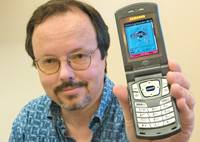 |
|
| David Robertson demonstrates the virtual frog dissection compression technology that makes web pages accessible via a “smart phone” and wireless service. |
In the wild, a frog may live 10 years, assuming it survives tadpolehood
and doesn’t get eaten by a bird or a fish or some other creature.
On the web, however, a virtual frog named “Fluffy” has
easily notched its tenth year despite millions of dissections.
Launched in June of 1994, Berkeley Lab’s Virtual Frog Dissection
Kit website allows users to virtually dissect a frog without all that
smelly formaldehyde of high school science class. Since then, more
than 15 million people in more than 130 countries have visited the
frog at http://dsd.lbl.gov/Frog/.
“We know it’s still being used because whenever the server goes down, we get a lot of email from around the world, mainly from teachers who use the site in their classes,” said Bill Johnston, head of DOE’s Energy Sciences Network (ESnet).
Johnston and other members of the former Imaging Technologies Group (now part of the Lab’s Distributed Systems Department) developed the Virtual Frog 10 years ago. While the site has remained virtually unchanged over the past decade, the research behind it has advanced by leaps and bounds, leading to Berkeley Lab’s prominent role in the development of Grid technologies.
“The Virtual Frog was a direct result of our early work in
wide-area distributed computing and visualization,” Johnston
said. “And this has led directly to our involvement in developing
collaborative technologies and Grid applications.”
The frog was originally spawned by the Lab’s work in developing
software to create visual renderings of sets of diagnostic cross-section
images used in medicine, which allow scientists to create 3D renderings
from MRI data.
Once the software was developed, Johnston said, he began to think about what to do with it. The line of thinking led to DOE’s education programs, and then to secondary schools. “Obviously, the choice was to create a frog.”
The first step was to obtain a specimen, purchased at a Berkeley pet shop and then euthanized following a strict, UC-approved protocol for handling animals for experiments. Once the amphibian was dead, lab assistant Katie Brennan brought it out to the team with her hands clasped around the creature. Opening them slowly, she declared, “Voila – Fluffy!” A star was named.
Next, the challenge was to use Berkeley Lab’s research MRI machine to create the layered images. “No matter what they did, the images came out mushy,” Johnston said. The cause turned out to be the dark green spots on the frog’s back. Containing iron oxide pigment, the spots set up magnetic fields that wreaked havoc on the imaging system.
Anat Biegon had a cryotome machine on campus that used a swinging diamond blade to make extremely thin slices of tissue. Fluffy was encased in a block of frozen thermosetting plastic and reduced to 130 slices, each one-tenth of a millimeter thick. After each slice was removed, the remaining portion of the frog was photographed.
Each of the photos was then digitized, and UC Berkeley biology student Craig Logan carried out the laborious task of segmentation — using a pen to outline critical organs or systems on each of the 130 slides. Wing Nip, a computer science student at San Francisco State University, worked with Logan to digitize the images.
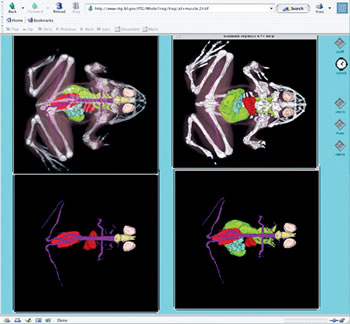 |
|
| “Fluffy” is being virtually dissected on the Virtual Frog Website. | |
“That is what allows you to manipulate 11 different anatomical
systems,” said David Robertson, who developed the Virtual Frog
Dissection Kit that makes the whole thing work. “This was one
of the first, if not the first, 3D rendering applications on the web.”
Back then, of course, there wasn’t a whole lot on the web. As
a result, the frog regularly made the “top 10 web sites”
lists, popular at the time. Because many people were still using 9,600
baud modems, Robertson compressed the images to make them more easily
accessible.
With no search engines and minimal marketing, the Virtual Frog leapt to prominence by word of mouth. “It rapidly shot up to 1.5 million hits a year,” Robertson added. “And it continues to get up to 40,000 hits a day.”
In a case of what is old becoming new again, the compression techniques that allowed quick display of images over a 9600-baud modem now enable people with “smart phones” to call up the Virtual Frog using the browsers on the phones, which typically have low-bandwidth wireless connections.
“I don’t think any of us realized how popular — and how enduring — the site would become,” Johnston said. “What started as something of an experiment has become an institution.”
Ultrafast X-Rays an Ultrahot Topic
BY LYNN YARRIS
Despite having to compete with the American Physical Society’s annual meeting in Denver, and in the face of tight travel budgets, a workshop on ultrafast x-rays held last week in San Diego drew some 150 attendees from across the nation and the world. Organized by Berkeley Lab and chaired by Stephen Leone, a chemist with the Lab’s Chemical Sciences Division, the workshop ran from April 28 to May 1, and stood out for the scientific diversity represented in its presentations.
“There were presentations from ultrafast laser, electron diffraction,
and synchrotron radiation facilities, and from the physics, materials,
chemical, and biological sciences,” said John Corlett of the
Accelerator and Fusion Research Division who gave a presentation on
LUX. “It was great to see this much diversity and that people
were engaged for each of the 11-hour days.”
Corlett was pleased with the response to his presentation. “That
LUX would provide the combination of spectroscopy and diffraction,
tunability and synchronization, and variation in the pulses, resonated
with the audience,” he said. “LUX would definitely fill
a number of scientific needs.”
See next story for a Q&A interview on this topic with John Corlett.
Shedding Light on LUX: A Talk with John Corlett
BY LYNN YARRIS
Ultrafast x-rays — those with pulse lengths in the femtosecond and attosecond timescales — have been identified as a target-rich area for scientific investigations. Berkeley Lab researchers have conceptualized a large new accelerator facility that would generate beams of ultrafast x-rays at pulse lengths ranging from 10 to 200 femtoseconds, with a goal of even shorter pulse lengths in the future. Called LUX, for Linac-based Ultrafast X-ray source, this facility is being developed under the leadership of John Corlett, a physicist with the Accelerator and Fusion Research Division, who serves as project director, and Stephen Leone, a chemist with the Chemical Sciences Division, who serves as science director. In a conversation with the View, Corlett discussed why this is the time and Berkeley Lab is the place for LUX.
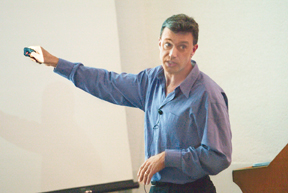 |
|
| John Corlett |
What was the scientific impetus for proposing LUX?
Through workshops and brainstorming sessions, it’s been established that there is a clear need for ultrafast time-domain studies in the x-ray region. We already have ultrafast lasers covering most of the visible, infrared and ultraviolet regions of the spectrum, but we need x-rays at 100-femtosecond pulse lengths to study critical aspects of the motion of atomic or molecular systems. It is necessary to have these x-ray pulses synchronized with ultrafast lasers that excite the sample. With femto-second timescale x-ray pulses, and control of the time delay between the excitation laser and the probe x-ray, resolution at tens of femto-seconds would allow detailed study of the dynamics of many systems, such as their response to inner electron shell excitations, and the structural changes that take place as a result of atomic or molecular motion.The ultrafast x-ray experiments that would be possible with LUX would include direct observations of chemical transition states and studies of photo-induced modifications of biological matter, high-speed magnetic effects and limits to magnetic-domain-changing timescales, interfacial phenomena, molecular wires and molecular electronics, and even the dynamics on timescales of electron motion.
What sets LUX apart from any of the approximately 40 other light sources in the world today?
LUX would be refined for the needs of ultrafast science, merging accelerator-based x-ray production with ultrafast lasers for exquisite time and spatial resolution. The primary component of the proposed LUX facility would be a 3 GeV recirculating superconducting linear accelerator. It would feature three recirculating rings, multiple, independently tunable beamlines, and experimental end-stations that would be coupled to lasers. The recirculating configuration would provide an electron bunch repetition rate that is well-suited to pump-probe dynamics experiments. LUX will produce coherent ultra-short pulses of soft x-rays that will have a peak flux several orders of magnitude higher than any existing storage ring light source. These pulses will also offer both a timing synchronization to excitation lasers and a spectroscopic tunability across the full range of EUV to hard x-ray wavelengths that aren’t available elsewhere. LUX will make it possible to do femtosecond x-ray diffraction, as well as spectroscopy experiments by offering incoherent sources of hard x-rays. It will have approximately 20 beamlines plus support resources set up to accommodate a large number of users simultaneously.Why would Berkeley Lab be the location of choice for a LUX-type facility, and where at the Lab would be the choice location for LUX?
Berkeley Lab and the UC Berkeley campus are already centers of ultrafast x-ray science expertise. We have scientists like Steve Leone, Roger Falcone, Daniel Chemla, Graham Fleming, Charles Harris, Joe Orenstein, Bob Schoenlein, Chuck Shank and others, who have the knowledge to put the capabilities of LUX to immediate scientific use and to guide others to achieve successful experiments. Berkeley Lab also has a history of ultrafast x-ray source development. In earlier studies we generated femtosecond x-ray pulses at the ALS Beam Test Facility, and are now able to slice femtosecond x-ray pulses off the ALS’ primary electron beam. These sliced x-ray pulses have given us a sample of what LUX could do, even though they are lower in flux and tunability. Finally, the large user base and support staff at the ALS will provide additional expertise that will be central to LUX.As for the best location here at Berkeley Lab, it would probably be in the Old Town area, adjacent to the ALS, replacing the existing buildings there. Having LUX next door to the ALS would be ideal for the users, sort of like a mall for x-ray science, where they could walk from one facility to the other, with static studies done at the ALS and time-domain at LUX.
How do you see the relationship between LUX and the ALS, or other facilities at Berkeley Lab?
Research at LUX would complement research at the ALS. The ALS is great for static studies using x-rays, offering high average power capabilities that are not duplicated with LUX. However, once you have static structural images of a sample and you want to observe how these structures may change over time, you can bring the samples to LUX. Research at LUX would also complement research at the Molecular Foundry because many of the time relationships critical to nanoscale events could easily be mapped out with LUX.LUX is projected to be able to one day provide spectroscopy on a attosecond time scale. What will scientists be able to do with this capability?
With attosecond x-ray spectroscopy capabilities, we should be able to follow electron cascades from one orbital to the next to discover the pathways of atomic and molecular decays. We might also be able to steer the motion of electrons and control not only chemical reactions but even the emission of light. Since the attosecond time-domain is an unexplored frontier, we don’t know what we’ll discover when we get there. However, we do know that the x-ray region is where attosecond time dynamics will be achieved, and there is great potential for discoveries that may change the way we understand the chemical world.What is the status of the LUX proposal today and what is the most optimistic timeline for its future?
The concept of LUX has been presented at workshops and to members of DOE’s Basic Energy Sciences Advisory Committee, where it has been applauded. We need funding from DOE to develop critical technologies. The LUX facility will need to produce x-rays at a 10 kilohertz repetition rate and operate reliably for long periods of time. This is pushing the current engineering boundaries in accelerator technologies. With sufficient funding, we could be ready to submit a formal project proposal to DOE within three years. If everything fell into place, LUX could produce its first light in the early part of the next decade.
OSHA Audit: Safety Is Everyone’s Responsibility
BY RON KOLB
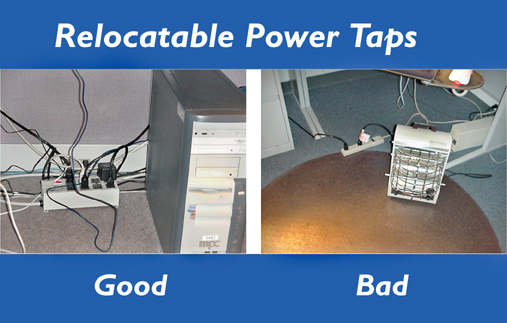 |
|
| Safe electrical practices are not always obvious. The multi-plug power strip (left) looks crowded, but it is being used properly and is considered safe. The space heater plugged into a strip (right) is not, due to appliance energy demands. | |
When the federal auditors from the Occupational Safety and Health Act (OSHA) office descended upon Berkeley Lab last January, you expected them to uncover the occasional cracked walkway, inadequate warning signage, or even a broken light fixture or two. But when two dozen safety sleuths spent two weeks looking under desks and behind doors, they were bound to find more.
And they did. They reviewed every laboratory and shop space, along with a sampling of office areas. They even climbed on top of the Advanced Light Source dome to check for fall protection tie-downs. But, contrary to what you might expect, many of the findings weren’t the big-time variety that EH&S managers and facilities workers respond quickly to repair. They were violations of simple rules, correctable with a little money and a lot of education.
Not unlike audits of the other nine Office of Science labs, the OSHA audit at Berkeley Lab identified a significant number of concerns, a full one-third of them electrical in nature — things like relocatable power taps (commonly known as power strips) in the wrong location, extension cords linked together, frayed electrical cords or deficient electrical plugs, high-current appliances such as space heaters and coffee pots plugged into power strips, and blocked electrical panels and cut-off switches.
Are you looking around your workspace right now?
“A lot of these fixes can and will be made by the management and employees of the Lab’s divisions,” said Robin Wendt, acting director of Environment, Health and Safety. “The audit report has emphasized the importance of every individual helping to make our workplace even safer. Working together, we can respond and address issues identified in the OSHA report and make a real difference.”
The good news is the OSHA team only found two “imminent hazards” — a hose holding open an elevator door by about one inch during maintenance and a construction trench that was slightly deeper than the legal limit of five feet. Both were immediately corrected.
In other areas, the auditors during their exit interview praised the
quality of Lab safety programs and communications, housekeeping, and
demonstrated follow-up actions.
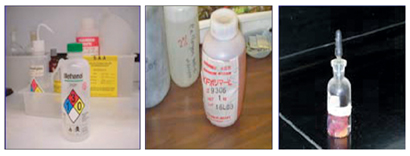 |
|
| (L)
Good (m) Not so good (R) Not so good |
“The Lab is committed to following OSHA standards and meeting its commitment to provide a safe workplace,” said Wendt. As a prime example, he noted that over this fiscal year, Berkeley Lab has been successful in improving workplace safety through its accident reduction program. “We’ve cut Lab accidents by more than half,” he said. “We’ve also cut by two-thirds the number of accidents that result in lost work days or days where an employee has work restrictions or is transferred.
“And,” he added, “Berkeley Lab has been a leader at keeping worker radioactive dose extremely low.”
Still, the total number of findings is nothing to ignore, according to Deputy Director Sally Benson. “We take the results of the OSHA audit very seriously,” she said. “OSHA standards are designed to help create a safe workplace. We are going to aggressively respond with a plan to correct all findings as soon as we can and to step up our assessment programs to better identify these issues.”
Some of the findings involved old infrastructure and old equipment, legacies of a facility that’s in its seventh decade. The Department of Energy has already allocated $830,000 this year to take care of some of these needed expenses, such as electrical repairs, emergency eyewashes and showers, and local exhaust ventilation. More funding is anticipated in future years.
The take-home message is one of vigilance and responsibility, Wendt said. Three-fourths of the findings had to do with electrical inadequacies (many in personal work spaces), exit signage and emergency lighting, machine guarding, materials handling, and walking-working surfaces.
First, he said, EH&S will capitalize on the partnerships between its liaisons and division safety coordinators to respond to the audit findings. In addition, messages about safety policies and practices will be conveyed regularly to all employees, within departments and via labwide vehicles like Today at Berkeley Lab and the View. The DOE has declared May “Electrical Safety Month,” and communications will focus on this area first.
The OSHA audits of the 10 Office of Science laboratories were part of a Congressional study on external regulation. Currently, DOE has authority for enforcing OSHA regulations at the science labs. Both Congress and the DOE have considered external regulation, but no decision to change from DOE regulation has yet been made.
LANA Celebrates Scholarship Winners
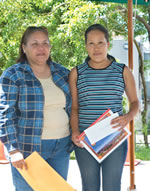 |
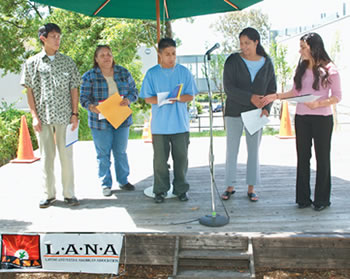 |
|
| Diana Guzman of Berkeley High was the recipient of the $500 scholarship award from Berkeley Lab’s Latino and Native American Association (LANA). | Honorary mention awards were presented by LANA President Alice Ramirez (second from left) to Roberto Huarcaya, Nelson Maldonado, Eleazar Martinez, and Jessica Leal. | |
At noon on Cinco de Mayo (May 5th), Berkeley Lab’s Latino and Native American Association (LANA) presented one of its two $500 scholarships for 2004 to Diana Guzman, a Berkeley High student who will be attending a local college. The other top prize went to Gustavo Orozco, who was not able to attend the ceremony and will be awarded his scholarship at a separate luncheon.
Also awarded were special $200 honorary mention awards to four students from Berkeley and Richmond High (top right). The generous scholarship awards this year were made possible by a special gift from the Lab’s Technical Electronic Information Department. TEID recently presented LANA
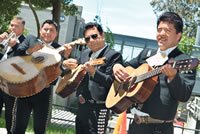 |
|
President Alice Ramirez with $800 for the group’s scholarship fund. The money was donated by Lab employees in honor of Ramirez’s mother, who recently passed away.
“We would like to thank the Berkeley Lab community for their continued support of our fundraising events,” Ramirez said.
LANA seeks to create and maintain a sense of cultural awareness for its members and Berkeley Lab. Its primary goal is to provide help to Native American and Latino American students in their quest of higher education. Attendees celebrated the event with Mariachi music.
The Nine Lives of Computer E-Waste
BY PAMELA PATTERSON
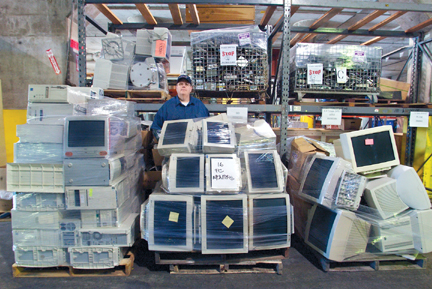 |
|
| Tom Hardy manages the storage site in Building 903, which includes mountains of castoff computer equipment. |
Ever wonder where the Lab’s old computers go to die once they’ve been scrapped for newer models? Ask Tom Hardy of the Facilities’ Reuse Center group. Hardy manages the Lab’s storage site in Building 903, including the ever-growing cache of electronic waste, or “e-waste.”
With computer technology advancing at an exponential rate, Lab employees, like consumers everywhere, are finding that their computers, monitors, printers, circuit boards and other peripherals are becoming obsolete faster than they can move the defunct equipment out from under their desks and work benches.
In fact, it’s estimated that a whopping 6,000 computers become obsolete every day in California. Add all the other castoff electronic components to the equation and the result is a veritable mountain of e-waste.
In the past, the bulk of such e-waste was routinely marked for dumping at municipal disposal sites. More than 4.6 million tons of waste entered landfills nationwide in 2001, according to the Environmental Protection Agency, with that amount expected to double by the end of 2004. That’s a problem, because such devices often contain hazardous materials such as lead, cadmium and mercury that can contaminate land, water and air. In fact, computer monitors alone — which average four to eight pounds of lead apiece — are currently the single largest contributor of lead to U.S. landfills.
Now, a February 2003 California law prohibits dumping of e-waste into municipal landfills, encouraging responsible organizations to arrange for the recycling and reuse of castoff equipment whenever possible.
Berkeley Lab takes this responsibility seriously, and the Lab’s Waste Management group makes every effort to appropriately categorize, handle, recycle and dispose of all its e-waste. Obsolete electronic items that are deemed reusable or recyclable wind up in Building 903 under Hardy’s care.
All functional equipment is placed on the Lab’s Excess Property database, which lists the type and condition of the components. Employees can search the list for items and pick them up free of charge.
Leftover e-waste that isn’t adopted, donated or recycled is sold in bid-lot sales to 40 or 50 local companies with which the Lab works on a regular basis. Computers first have their hard drives erased to ensure no data is mistakenly sent off the Hill.
Finally, more expensive equipment — anything worth over $5,000 — is listed on the Federal Excess List website, with the option to be obtained by qualifying federal agencies. Medical equipment over $2,000 is made available to any qualifying college or university in the country.
So how do you get rid of that e-waste competing for your own office floor? The simplest way is to visit the e-waste guidelines site at http://www.lbl.gov/ehs/waste/html/ewaste_guide_general1125031.pdf. Determine what kind of equipment you have, and follow the directions for proper handling. And don’t forget to notify Property Management about any equipment leaving your care so they can record that you are no longer responsible for it.
Berkeley Lab View
Published every two weeks by the Communications Department for the employees and retirees of Berkeley Lab.
Reid Edwards, Public Affairs Department head
Ron Kolb, Communications Department head
EDITOR
Monica Friedlander, 495-2248,
msfriedlander@lbl.gov
Associate EDITOR
Lyn Hunter, 486-4698 lhunter@lbl.gov
STAFF WRITERS
Dan Krotz, 486-4019
Paul Preuss, 486-6249
Lynn Yarris, 486-5375
CONTRIBUTING WRITERS
Jon Bashor, 486-5849
Allan Chen, 486-4210 David Gilbert, 925-296-5643
FLEA MARKET
486-5771, fleamarket@lbl.gov
Design & Illustration
Caitlin Youngquist, 486-4020
TEID Creative Services
Communications Department
MS 65, One Cyclotron Road, Berkeley CA 94720
(510) 486-5771
Fax: (510) 486-6641
Berkeley Lab is managed by the University of California for the U.S. Department of Energy.
Online Version
The full text and photographs of each edition of The View, as well as the Currents
archive going back to 1994, are published online on the Berkeley Lab website
under “Publications” in the A-Z Index. The site allows users to
do searches of past articles.
HIF: The Other Approach to Fusion
BY LYNN YARRIS
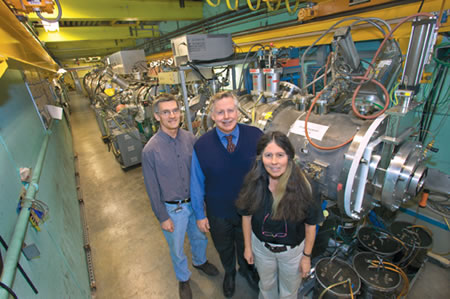 |
|
| High Current Experiment with (left to right) Peter Seidl, Grant Logan and Christine Celata. | |
In 1956, a geophysicist named Marion King Hubbert announced a formula which predicted that the rate at which oil could be extracted from the lower 48 states would peak around 1970 and begin a rapid decline. Hubbert’s calculations were presented at a time when the U.S. was awash in “black gold” and Hubbert became a laughingstock. But his prediction would turn out to be true, and the Hubbert peak is no longer a laughing matter today. Calculations show global oil production could reach the Hubbert peak within this decade. We need to find alternative energy sources soon.
Towards this end, in 1999, after decades of individual institutional efforts, researchers with Berkeley Lab, Lawrence Livermore National Laboratory (LLNL), and the Princeton Plasma Physics Laboratory (PPPL) formed the U.S. Heavy-Ion Fusion Virtual National Laboratory (HIF-VNL). This collaborative effort is now under the leadership of Grant Logan, a physicist with Berkeley Lab’s Accelerator and Fusion Research Division (AFRD).
The goal of the HIF-VNL is to develop heavy ion accelerators capable of creating a fusion reaction by imploding tiny capsules of nuclear fuel. Heavy ion fusion (HIF) is the alternative to fossil fuels that hasn’t received the public attention given to magnetic fusion energy (MFE), the tokamak-based concept behind ITER — the International Thermonuclear Experimental Reactor. Despite the lack of public recognition, HIF-VNL resear-chers have continued to make steady progress.
“We’ve completed three years of good research with results that are proving some of our most complicated concepts to be viable,” says AFRD physicist Christine Celata, who was invited to speak on the latest developments in HIF-VNL research at this year’s annual meeting of the American Physical Society, held in Denver May 1 through May 4. This is the second year in a row that APS invited her to give a talk.
Fusion, the energy source that lights up the stars, takes place when lighter atomic nuclei are fused together to form heavier nuclei. In an HIF reactor, an imploded pea-sized capsule of nuclear fuel burns quickly enough to be confined by its own inertia to produce energy. The implosion that ignites the fuel is set off or “driven” by high-powered beams of heavy ions that are focused on the capsule.
HIF researchers must find a way to transport and focus heavy ion beams whose total current might reach 500,000 amperes by the time they reach the target. At such high current, space-charge forces — the mutual repulsion between so many positively charged ions — become a serious impediment.
Experiments in the 1980s and 1990s at Berkeley Lab demonstrated the potential of driving HIF reactions by simultaneously bombarding a fuel capsule with the combined energies of multiple, independently focused, lower current beams. These earlier experiments, however, left critical questions unanswered that are being addressed by the latest HIF-VNL experiments.
Determining optimum beam size and the best means of preserving beam quality during transport are the goals of the High Current Experiment (HCX) being carried out at Berkeley Lab. The HCX consists of an ion injector plus 10 electrostatic and four magnetic quadrupole magnets.
“The HCX is the first transport experiment using a driver-scale heavy-ion beam,” says Celata. “It allows us to test aperture limits, electron and gas effects, halo formation and steering. This information is crucial for designing future experiments and HIF drivers that will minimize the size and cost of multiple beam arrays.”
The Neutralized Transport Experiment (NTX), also based at Berkeley Lab, is designed to investigate beam physics in the final focusing system after the ion beams have been neutralized. Beam neutralization for the final run at the target counteracts space-charge forces and enables the beam’s energy to be focused to a smaller spot. Consisting of a 400-kilo electron volt (keV) injector, four magnetic quadrupoles, and two plasma sources for neutralization, the NTX has already been used to demonstrate dramatic reductions in beam spot size.
“A 25 milliamp beam at 255 keV transported through a tube 7.6 centimeters in diameter was focused to a 14.7 millimeter radius when non-neutralized,” says Celata. “This same beam, when neutralized, was focused to a radius of only 1.26 millimeters.”
A third major HIF-VNL experiment, being carried out at LLNL, is testing the concept of an injector that merges many small beamlets (a radius of about 100 millimeters) into a single intense heavy ion beam.
After these latest tests are concluded, probably within a couple of years, the next step in the HIF-VNL program calls for the Integra-ted Beam Experiment (IBX). This experiment will enable HIF-VNL researchers to follow at least one beam from injection through acceleration, longitudinal drift-compression, and final focus, with sufficient beam current to observe interactions with the background gas or with secondary electrons.
“The IBX might last from five to eight years, and after that
we’d be ready for the Integrated Research Experiment, which
would test all the components and physics needed for a commercial
HIF reactor,” says Celata. “I’m optimistic about
our chances for success.
An expanded story on the HIF-VNL program will appear in the next issue
of Science Beat, Berkeley Lab’s online magazine at http://enews.lbl.gov/
publication.
A Conveyor Belt for the Nano-Age
BY DAN KROTZ
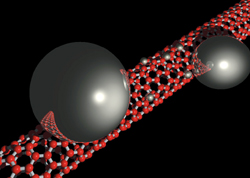 |
|
| Someday, nanoscale conveyor belts could expedite the atom-by-atom construction of the world’s smallest devices. |
In a development that brings the promise of mass production to nano-scale devices, Lawrence Berkeley National Laboratory scientists have transformed carbon nanotubes into conveyor belts capable of ferrying atom-sized particles to microscopic worksites.
By applying a small electrical current to a carbon nanotube, they moved indium particles along the tube like auto parts on an assembly line. Their research, described in the April 29 issue of Nature, lays the groundwork for the high-throughput construction of atomic-scale optical, electronic, and mecha-nical devices that will power the burgeoning field of nanotechnology.
“We’re not transporting atoms one at a time anymore — it’s more like a hose,” says Chris Regan of Berkeley Lab’s Materials Sciences Division, who co-authored the article along with fellow Materials Sciences researchers Shaul Aloni, Ulrich Dahmen, Robert Ritchie, and Alex Zettl. Aloni, Regan, and Zettl are also scientists in the University of Cali-fornia’s Department of Physics, where much of the work was conducted.
The ability to shuttle a stream of particles to precise locations fills a void that has stymied the efficient assembly of nanostructures. For years, scientists have been able to simultaneously deliver millions of atoms to millions of sites simply by mixing chemicals. Although this fast technique has grown quite sophisticated, it remains far too blunt to build atomic-scale devices. On the other end of the spectrum is the ability to manipulate individual atoms, a feat that came of age in 1990 when IBM researchers spelled out the company logo by positioning 35 xenon atoms with a scanning tunneling microscope. Although precise, this technique is painstakingly slow, with no way to swiftly deliver atoms to the work area.
“It’s either all at once, or excruciatingly serial,” says Regan. “So we combined incredibly precise localization with something that has higher throughput.”
As described in their Nature article, the research team thermally evaporated indium metal onto a bundle of carbon nanotubes. The amount of evaporated metal is so small it populates the tubes’ surfaces as isolated indium crystals, instead of uniformly coating them. The bundle is then placed inside a transmission electron microscope, where a tungsten tip mounted on the end of a nanomanipulator approaches one nanotube. After physical contact is made between the tip and the free end of the nanotube, voltage is applied between the tip and the other end of the nanotube, creating a circuit. This sends an electrical current through the nanotube, which generates thermal energy that heats the indium particles.
Next, if the voltage and thermal energy is carefully controlled, something strange occurs. Real-time video of the nanotube’s surface captures an indium particle as it disappears, while the particle to its right grows. Several seconds later, that newly enlarged particle also disappears, replaced by another even further to the right. Like squeezing the last bits of toothpaste from a tube, particles to the left become smaller while those to the right grow.
“Our nanoscale mass delivery system is simple and reversible. It requires only a nanotube, a voltage source, and something to transport,” Regan says.
Hollow Nanocrystals and How to Mass Produce Them
BY PAUL PREUSS
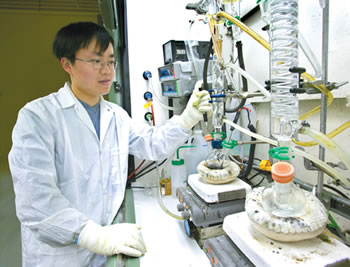 |
|
| Yadong Yin and his colleagues use a three-necked flask to create hollow nanocrystalline structures in a "one-pot" process. | |
Recently, Yadong Yin and his colleagues in Paul Alivisatos’s laboratory were experimenting with ways to modify the surfaces of nanocrystals — particles only a few billionths of a meter in size, comprised of only a few thousand atoms. After exposing cobalt nano-crystals to sulfur, they examined the results under a transmission electron microscope.
What they saw came as a surprise: the numerous solid crystals had turned into hollow spheres.
Alivisatos is director of Berkeley Lab’s Materials Sciences Division and a professor of chemistry at UC Berkeley. His laboratory, in which Yin is a postdoctoral fellow, has been the source of numerous discoveries and inventions on the nanoscale. But while the mass production of nanoscale hollow spheres would be an exciting addition to the repertoire, it presented a puzzle.
“After we talked about what we’d observed, we decided that a process called the Kirkendall Effect was responsible for the hollowing out of the spheres,” says Yin.
Discovered in 1947, the Kirkendall effect describes what happens when two solids diffuse into each other at different rates. The boundary between two metals, zinc and copper for example, is formed by a growing layer of alloy — brass, in this case — which expands in the direction of the faster-moving species, zinc.
This was the clue to Ernest Kirkendall’s discovery that the atoms of the two solids don’t change places directly; rather, diffusion occurs where voids open, making room for atoms to move in. In the wake of the faster-moving material, large pores or cavities form as unfilled voids coalesce.
“Most of the time people don’t like this,” says Yin. “It can be a big problem in welding, for example. But we saw the possibilities.”
Yin and his colleagues realized that in a sulfide-coated cobalt nanocrystal, cobalt atoms rapidly move outward, leaving voids behind, while sulfur atoms move sluggishly inward. A rind of cobalt sulfide forms as they mix. Meanwhile the inner voids coalesce. Once all the cobalt has diffused into the sulfide, what’s left is an empty sphere.
“We have lots of practice with cobalt nanoparticles, so we used cobalt to demonstrate the effect,” says Yin. “We made hollow nanospheres of cobalt oxide, cobalt sulfide, and cobalt selenide.” Then, to show that the process worked for metals generally, they also made hollow nanospheres of iron oxide and cadmium sulfide. “It gave us the confidence to say we could make hollow nanocrystals with many different materials.”
The nanospheres were remarkably uniform: depending on the proportions of the starting materials, their hollow centers were 40 to 70 percent as big as the initial crystal, but hole size varied no more than 13 percent in any given batch. This uniformity and versatility suggested a wide range of applications, including drug delivery systems, optics, electronics, and selective chemical reactors — all on the nanoscale.
To demonstrate the possibilities, Yin and his colleagues in Alivisatos’s laboratory consulted their neighbors in Gabor Somorjai’s laboratory. Somorjai, also with the Materials Sciences Division and the UCB Chemistry Department, is an international authority on catalysis who has experimented with arrays of nanocrystals on a surface.
Somorjai encouraged the research-ers to isolate catalyst particles, such as platinum nanocrystals, inside their hollow shells. Compared to catalysts on open surfaces or in the channels of porous structures, catalysts confined in this way could reduce secondary reactions and deliver just the desired reaction products in the desired amounts.
“At first I thought it would be impossible,” says Yin, “but then we saw how we could do it.” The synthesis began with platinum nano-crystals, or “seeds.” Cobalt was added to form structures with platinum cores and cobalt shells.
Now the outer cobalt shells were oxidized, launching the familiar
Kirkendall-like process: the cobalt diffused rapidly outward, the
oxygen slowly inward, forming hollow spheres of cobalt oxide with
platinum seeds rattling around in their centers.
In a test, the confined catalysts efficiently promoted the reaction
of ethylene (C2H4) and hydrogen to form ethane (C2H6). One puzzle
remained: how did the ethylene and hydrogen get inside the cobalt
oxide shells to reach the platinum, and how did the ethane get out?
“We assume these small molecules are traveling along grain boundaries through the shell,” Yin says, “but this is not completely understood. It’s something we’re still studying.”
Meanwhile, the manufacturing process is remarkable in itself. “Unlike a lot of organic chemistry, where you have many steps and lose a lot of material, this is a one-pot synthesis,” says Yin. “You just add things, one at a time. You don’t have to take anything out to purify the products in each step. You keep 100 percent of what you’ve made.”
It’s the beginning of mass production of complex nanoscale structures whose practical applications, already demonstrated, have barely begun.
“Formation of hollow nanocrystals through the nanoscale Kirkendall effect,” by Yadong Yin, Robert M. Rioux, Can K. Erdonmez, Steven Hughes, Gabor A. Somorjai, and A. Paul Alivisatos, appeared in the April 30, 2004 issue of Science.
Director Predicts Berkeley Lab Will Sail On
BY RON KOLB
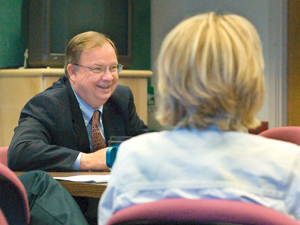 |
|
| Lab Director Charles Shank talks to employees during Wednesday’s Brown Bag. |
As he prepares to sail off into the sunset — literally, in a boat race to Hawaii — Laboratory Director Charles Shank gave an upbeat assessment of the Lab and its future at an informal conversation with employees on Wednesday.
“The Lab will greatly benefit from new eyes — someone with new ideas, new ways of thinking,” Shank said of his successor, who is expected to be announced by the University of California in the next few weeks. “The Lab is in good shape, with a budget of about $520 million, higher than ever before. It’s world-class, and I’m sure we’ll get a world-class person to step up and do this (manage the lab). I look very positively on the future here.”
He added that he “will miss this Lab. It’s been a great opportunity for me for 15 years.” But he told the audience in Building 90 that, beginning with the Pacific sailboat race this summer, it will be time for him to pursue other interests, including a long-postponed sabbatical. After that? “I have research thoughts that I’ve suppressed in recent years,” Shank said, indicating he might return to campus.
During this fourth in a series of Brown Bag luncheon discussions, Shank also outlined what he thought would be the process for Berkeley Lab’s first-ever contract competition. Following the issuance of a draft Request for Proposals (RFP) later this month, a month for comment and input will be allocated. Each competitor will then have 45 days to prepare an oral presentation for the Acquisitions Board. A final decision is expected by year’s end.
Shank repeated his earlier opinion that “there won’t be a competitor, so we will probably be competing against ourselves.” He said the Lab’s prior history with the University, plus a proposal preparation price tag of $5 million, will tend to discourage many prospective bidders. In any event, he emphasized, “It’s very important for the laboratory to do an outstanding job. Congress and the DOE expect that you will do well, to show how you will make the Lab more effective and business-like.”
Shank was joined at the dialogue by Deputy Director Pier Oddone, who added, “After you win the competition, it’s not over. You still have to negotiate a contract (with the DOE).”
Other discussion topics included improved Lab-community relations
(“the best I’ve seen in 15 years,” Shank said),
potential discrepancies in business services between campus and Lab,
and the vision for a “human element” in future Lab site
development as reflected in the forthcoming Long Range Development
Plan.
Flea Market
- AUTOS & SUPPLIES
‘97 MAZDA MIATA MX5, blue/green convertible, air, pwr win, CD player, runs & looks great, 97K mi, pd registration, passed smog, have title, Jennifer, (925) 381-6967
UTILITY TRAILER, 4x8, 1,000 lb capacity, permanent DMV license, $75, Dick, X5516, (925) 437-6007
HOUSING
ALAMEDA, 2 bdrm/1bth apt in charming Victorian bldg, hardwd flrs, high ceilings, walking dist to shops/shopping ctr, very quiet bldg, no pets/smok, avail 6/1, $1,350/mo, Janice, 895-3584
BERKELEY, Carleton/Grant, nr BART/ shops/lab shuttle, close to LBNL, newly renov 2 bdrm apt, ground flr of 2-story Victorian house, sunny southern exposure, fr garden, w&d, custom tile flrs, no smok/pets, $1,400/mo, incl part utils, avail immed, Richard or Hope, 845-1723
BERKELEY HILLS, inlaw apt, 1 bdrm/1 bth, fully furn apt in brown shingle home, nr Kensington border, very quiet resid neighbrhd, priv patio, spacious liv rm, marble bthrm, carpet, built-in natural woodwork, lage bdrm w/ king bed, fully equipped kitchen, free cable TV, nr shopping/pub trans/UC, $1,190/mo, $600 dep, no pets/smok, avail immediately, Ivankash@hotmail.com, Helga, 524-8308
BERKELEY HILLS, by wk/mo, quiet furn suite sleeps up to 3 in 2 bdrm/1 bth, quiet, eleg & spacious, bay views, DSL, cable, microwave, walk to UCB, Denyse, 848-1830, gfchew@mindspring.com
CENTRAL BERKELEY, nice furn rms, kitchen, laundry, PC, DSL, hardwd flrs, brkfst, walk to campus/shops, $800/mo incl everything, (925) 595-2608, AshleyUlmer@sbcglobal.net
CENTRAL BERKELEY, 2 bdrm/1 bth furn house, across from N Berkeley BART station, furn, all dishes, linens, 2 bdrms: one w/ king-sized bed, one as office, w/d, avail in July for yr lease, $1,850/mo or $500/wk for summer terms, Helen, 848-6385, BandB@brownshingle.com
EMERYVILLE/OAKLAND, on Berkeley border, furn bdrm in 2 bdrm/1 bth duplex, priv, rm w/ hardwd flr, lge double closet, garage, w/d, dw, furn liv rm, hardwd flrs, close to shopping/BART, share w/ female, sublet for 6 mo starting 7/04, dates neg, $550/mo + util, female pref, Prisca, 652-6434, pnodora@earthlink.net.
KENSINGTON, fully furn 3 bdrm home, view, quiet setting, 1 cat, avail for visiting scientist during summer & fall terms, $1,600/mo + sec dep, Ruth, 526-2007, 526-6730
NORTH BERKELEY 3 blocks from UCB, by wk/mo, fully furn 1/1 flat, quiet, spacious & comfortable, laundry rm, priv garden, gated carport, walk to shuttle/UCB/ BART/downtown, Geoff, 848-1830, fchew@mindspring.com
NORTH BERKELEY, lovely room w/ priv bth for rent in beautiful non-smok/no pets, quiet house, furn (bed, desk, dresser), incl kitchen, laundry priv, nr pub trans, for single, responsible pers, $575/mo incl util, Ms. Wurth, 527-5505 aft 1:30 pm, nonet@xoma.com
NORTH BERKELEY HILLS studio apt, newly refurb, priv entr w/ small deck, tree house feeling, semi-furn, mo-to-mo lease, stairs, no smok/pets, nr pub trans, parking & util incl, $925/mo, avail 6/7, 527-7732, lrw7732@pacbell.net
NORTH BERKELEY, short term housing, 6/12-7/30, beautiful 3bdrm/1 bth fully furn house, within walking dist to Solano Ave, tenant responsible for the care of a cat & a bunny, $1,500, SRManshadi@ lbl.gov, Nazeer,526-1468
PLEASANT HILL, sunny 3 bdrm/2 bth home, lovely backyrd, walk to schools & park w/ hiking trails, quiet neighbrhd, ac, AEK, hardwd flrs, 1 yr. lease, avail 6/15, $2100/mo, 1st + dep, Steve, X6228, slsohner@lbl.gov, (925) 631-0668
ROCKRIDGE, 3 bdrm/1.5 bth house, 3 blks from BART, remodeled kitchen & bthrms, refrig, gas stove, w/d, finished basement, 1-car garage, nice enclosed courtyard, avail 6/1, $2,300/mo, Otis, X4046, onwong@lbl.gov
WEST BERKELEY, studio apt, 560 sq ft, bright & sunny w/sep kitchen/din, sm deck, wood stove, newly painted, carpeted, stove & fridge, 3 bl from University Ave, $775/mo+ last mo & dep, Andrea, X6727, 644-1667
MISC ITEMS FOR SALE
BICYCLE, 2001 Cannondale Bad Boy Rigid XL, 20” c-c, 26” wheels w/ street tires, Shimano XL rear derailer, V-brakes, Blackburn rear rack, bar ends, $450, John, X7279
CRATE for dog or cat, approx 33x22x26 in, $20/bo, Bob, 642-2156, 527-2937 eves
MICROCASSETTE TRANSCRIBER, Olympus Optical Pearlcorder CM500, electronic, $100/bo, Maria, X6184, 482-4303
SOFA & RECLINER, leather, 82” light brown, leather sofa and matching recliner, $100 for both, Gary, X7727
STOVE, 1920’S Wedgewood, 6 burners, 2 ovens, right side warmer, broiler storage, almond w/ green trim, 62”x31”x56”, exc cond, $6,500/bo, Edward, X4575
FREE
TAPE RECORDER, AKAI M-8 reel to reel, Jerry, X5316
LOST & FOUND
FOUND: KEY on a key ring in the Bldg 6 parking lot, Wednesday, April 21, Sharon, X4991
LADIES WATCH on the offsite bus, missing crystal, Liz X6179
VACATION
LAKE TAHOE house, 3 bdrm/2.5 bth, fenced yrd, quiet sunny location, great views of water & mountains, $195/night, 2 night min, Bob, (925) 376-2211
PARIS, FRANCE, nr Eiffel Tower, furn, eleg, sunny 2 bdrm/ 1bth apt, avail yr-round by week/mo, close to pub trans/shops, Geoff, 848-1830, gfchew@mindspring.com
Flea Market Policy
Ads are accepted only from Berkeley Lab employees, retirees, and onsite DOE personnel. Only items of your own personal property may be offered for sale.
Submissions must include name, affiliation, extension, and home phone. Ads must be submitted in writing
(e-mail: fleamarket@ lbl.gov, fax: X6641,) or mailed/delivered to Bldg. 65.
Ads run one issue only unless resubmitted, and are repeated only as space permits. Ads must be submitted in writing and be no more than 50 words in length. The submission deadline for the April 30 issue is Friday, April 23.